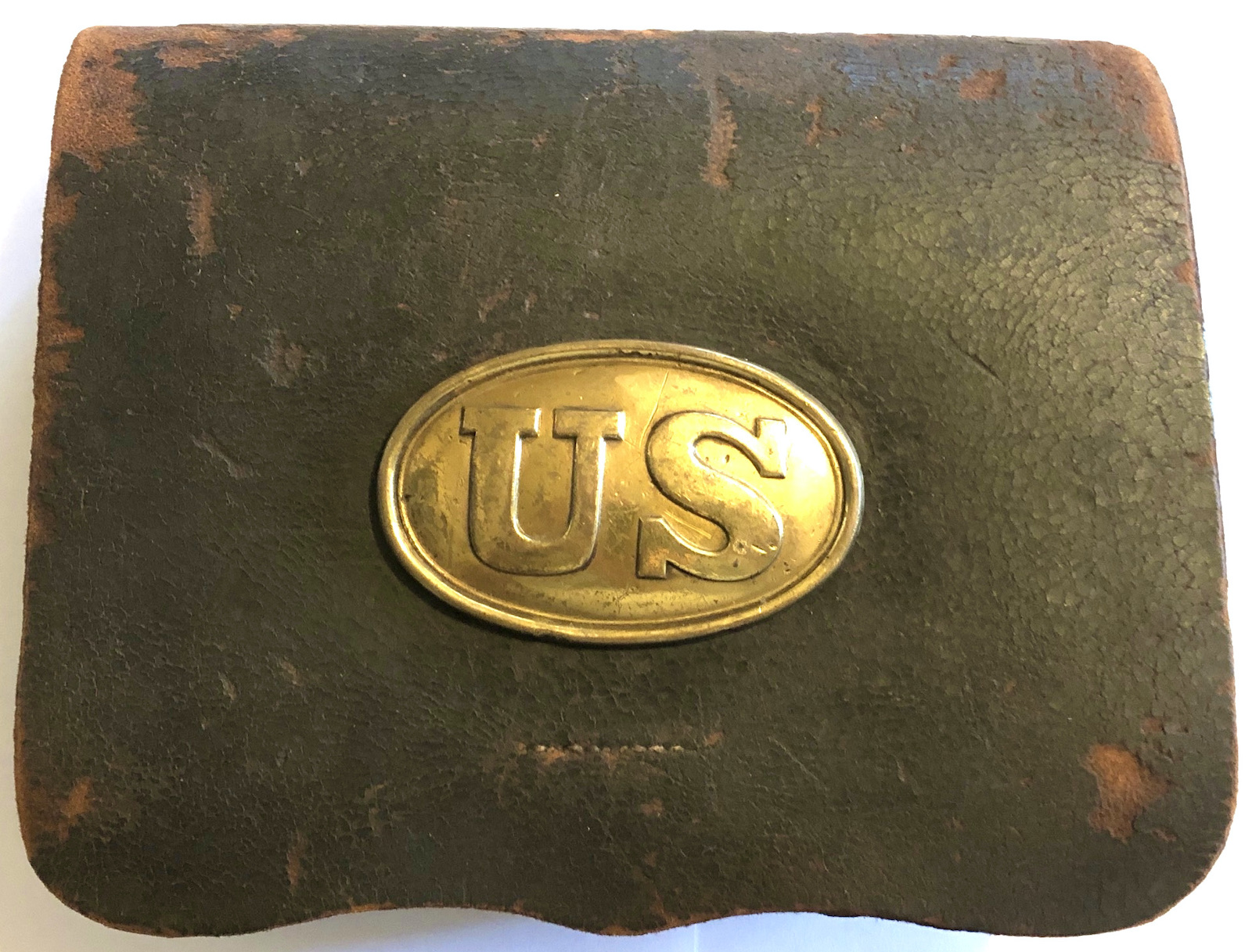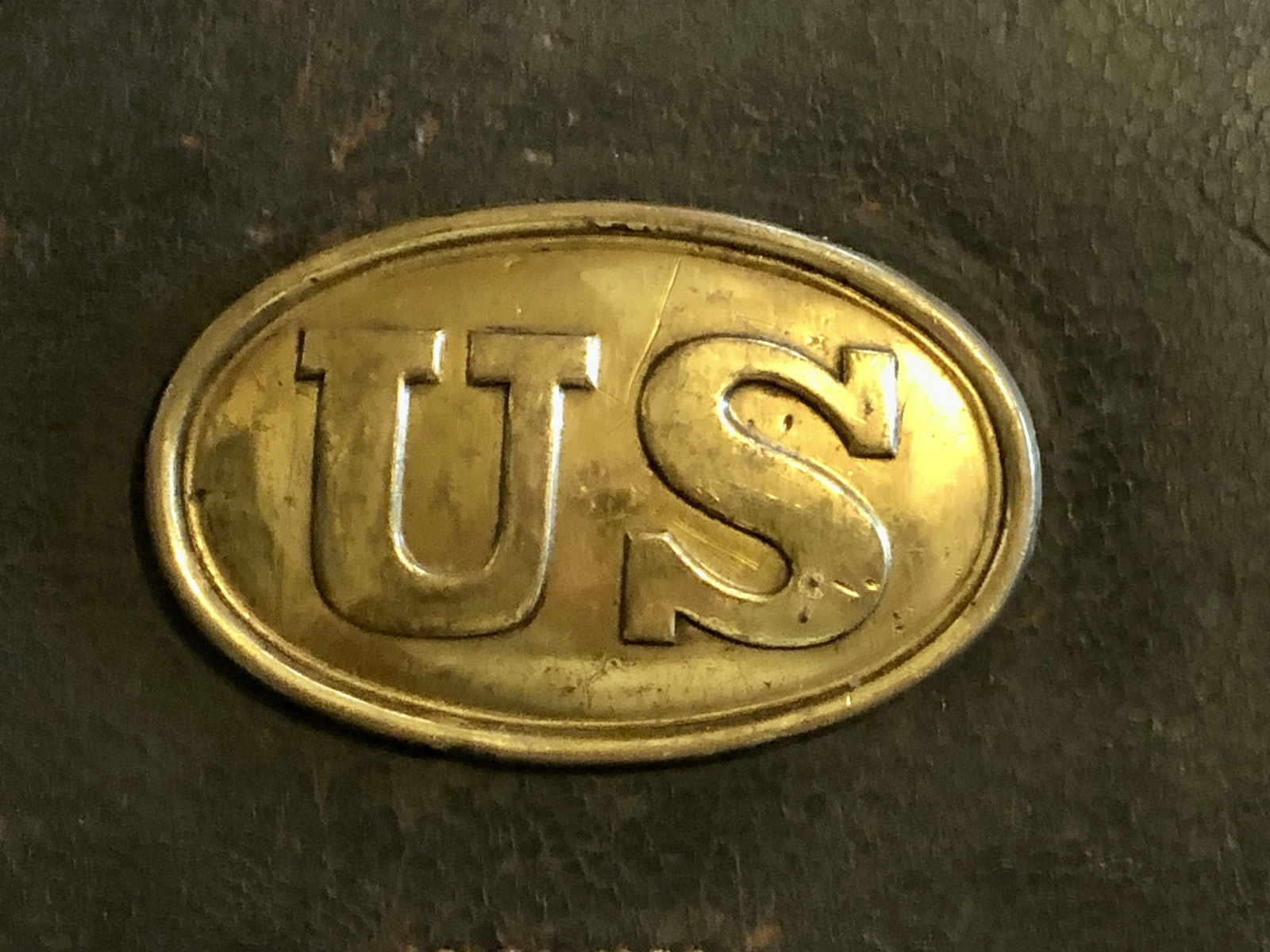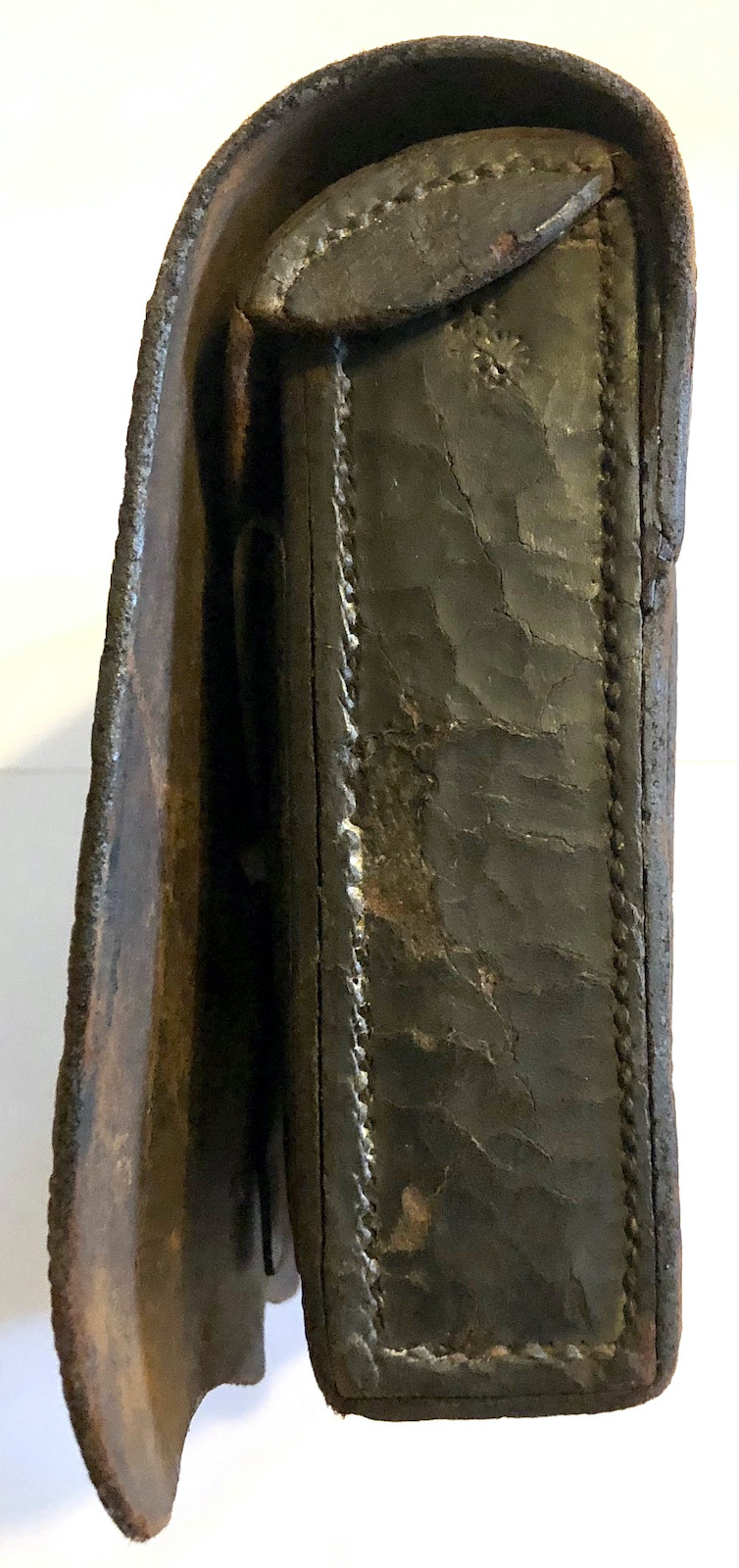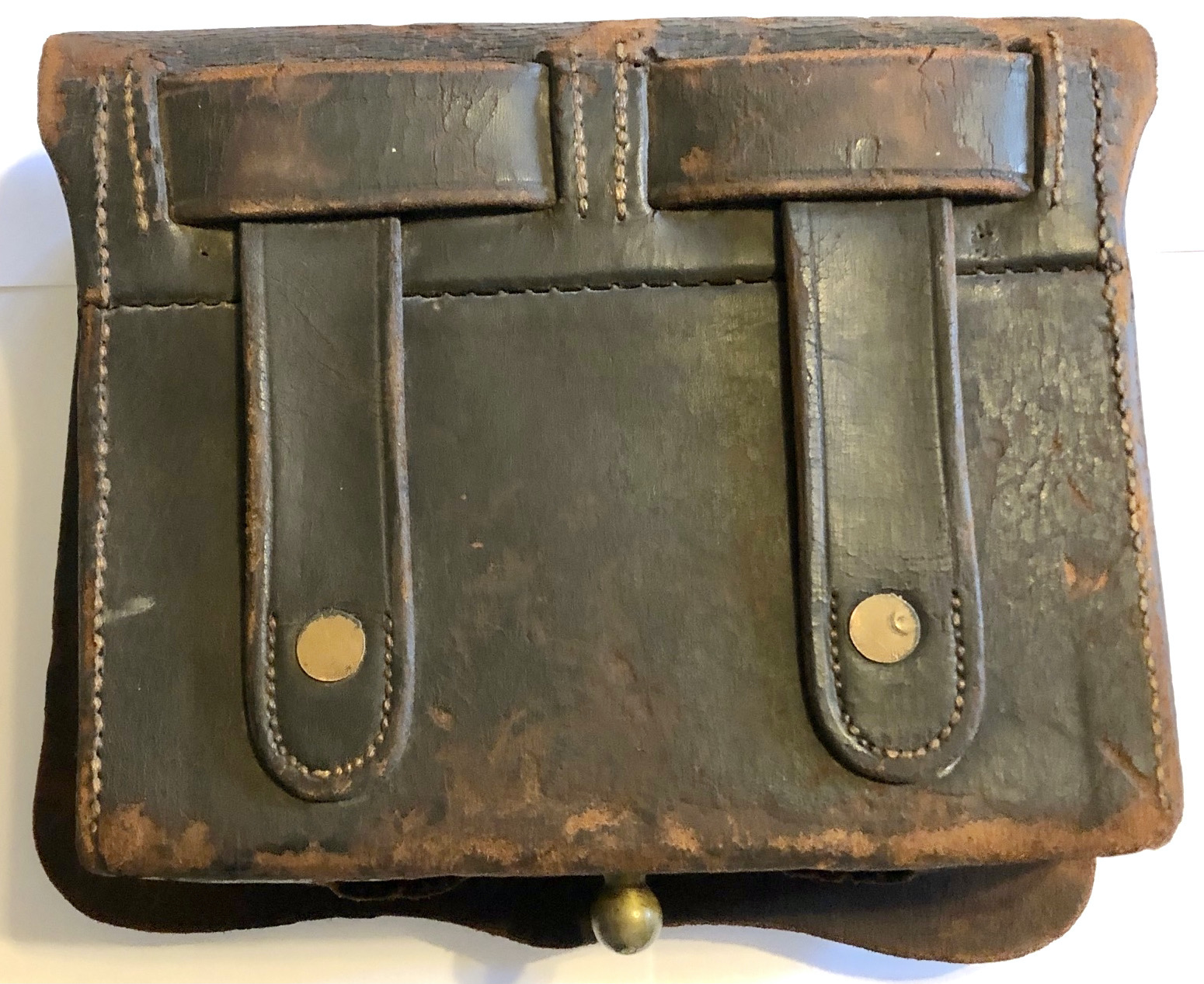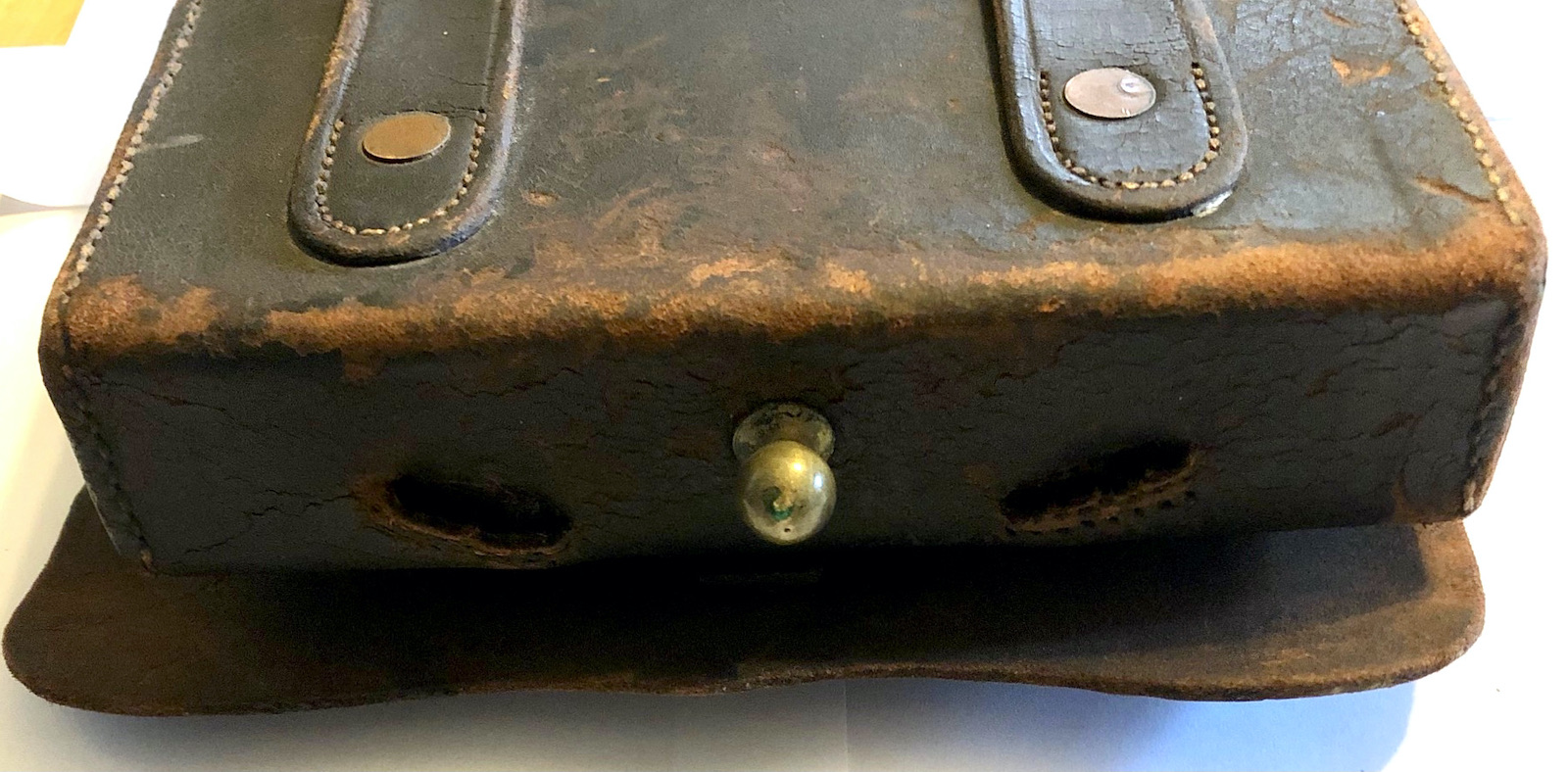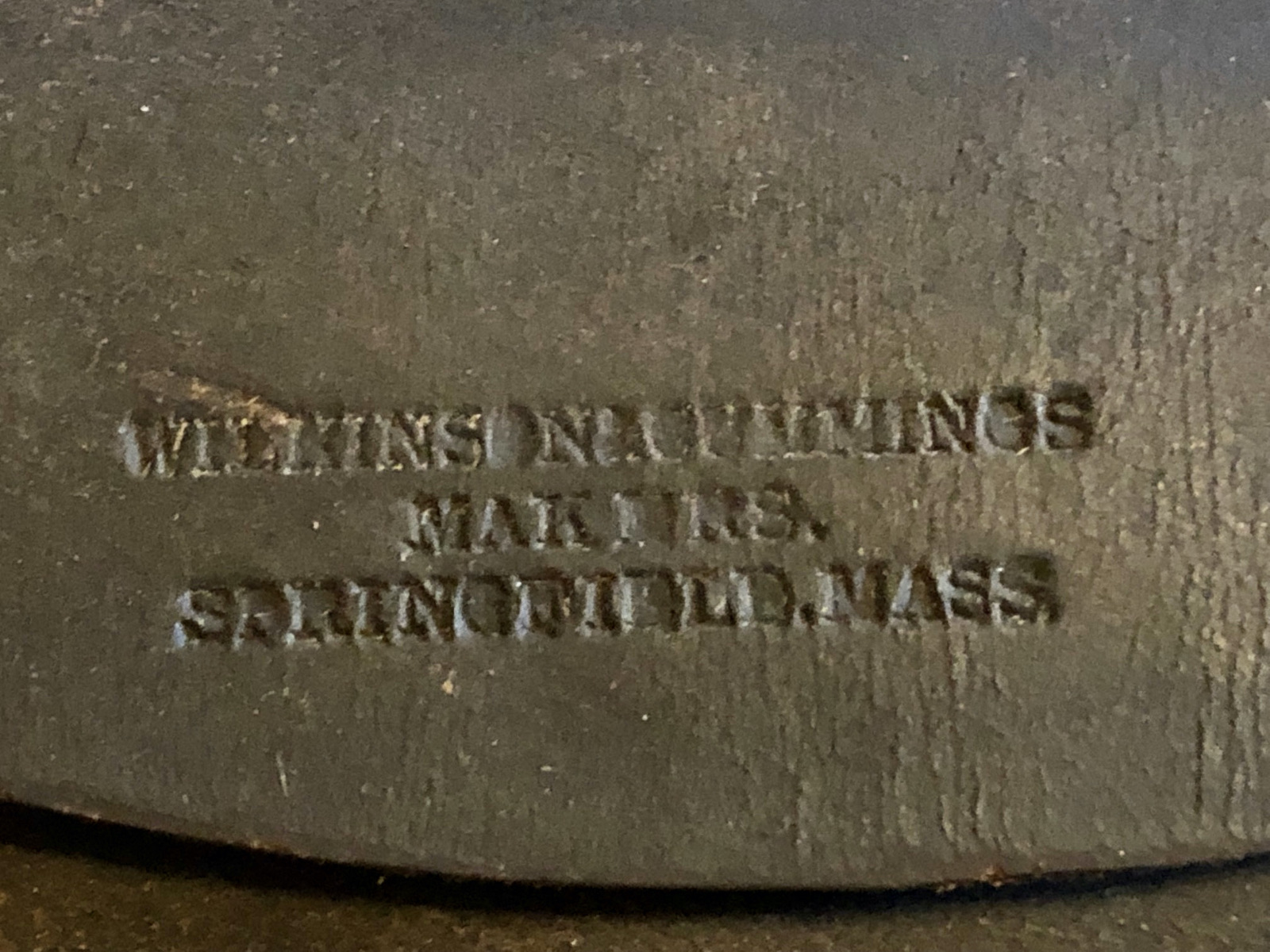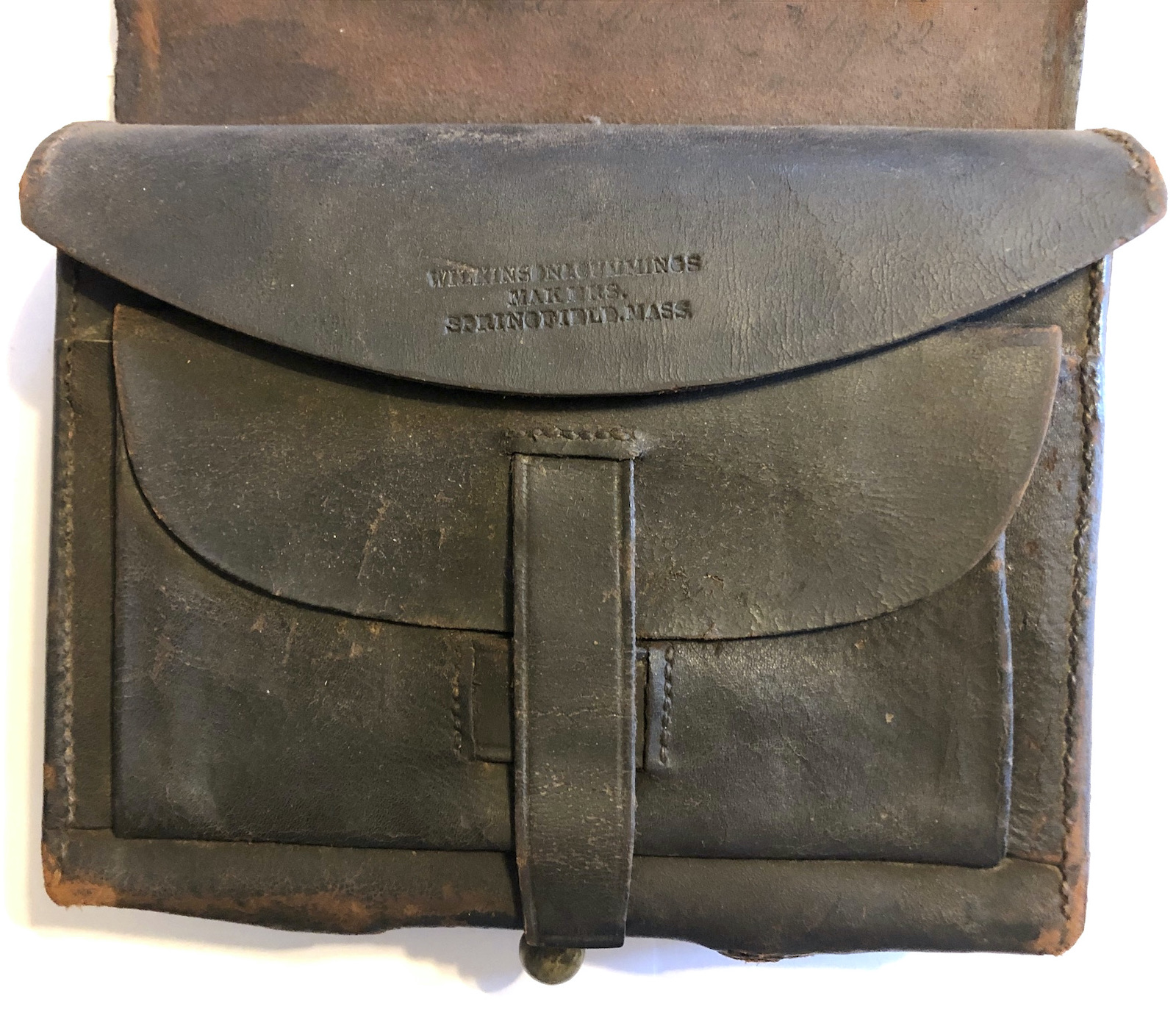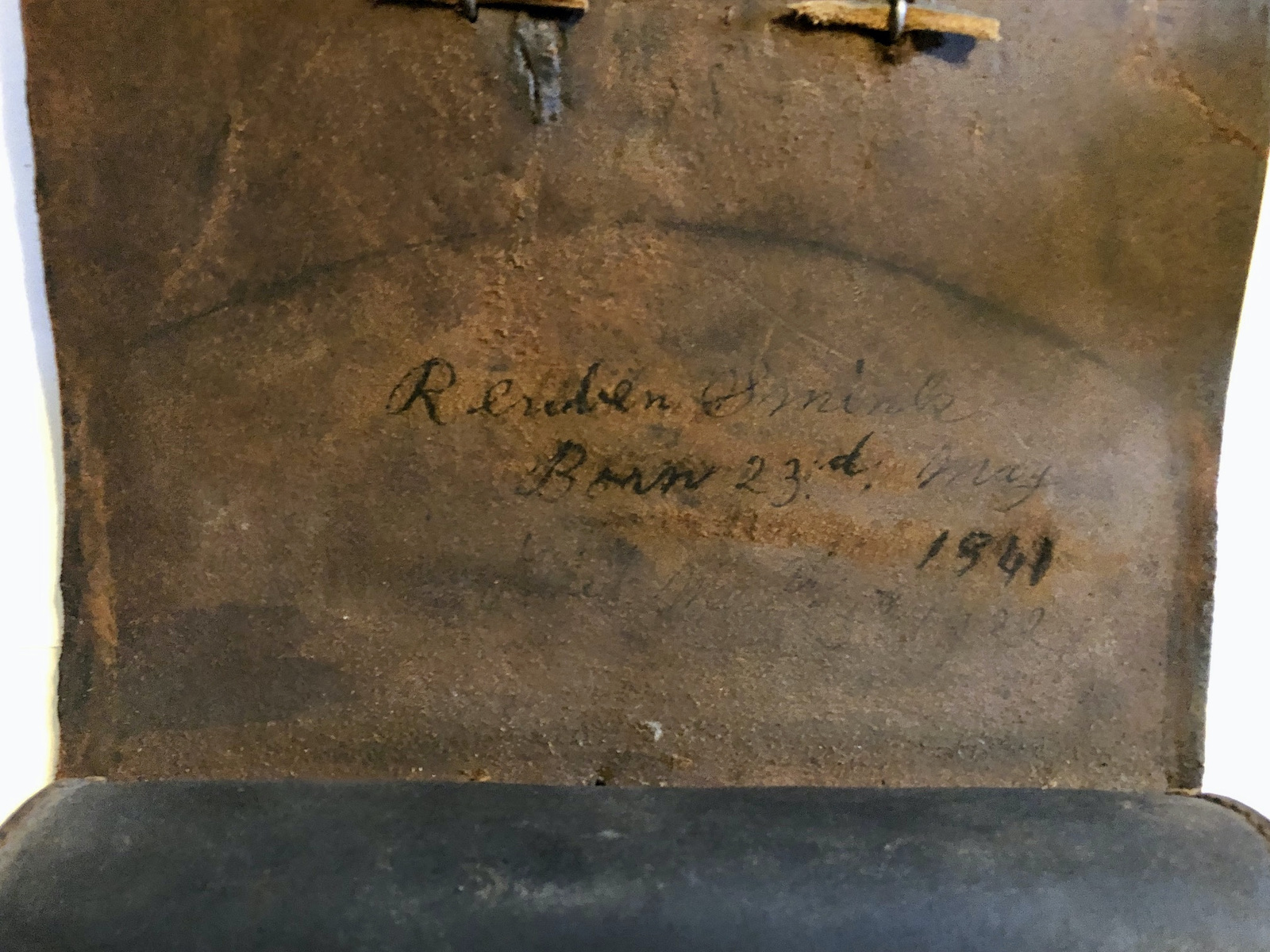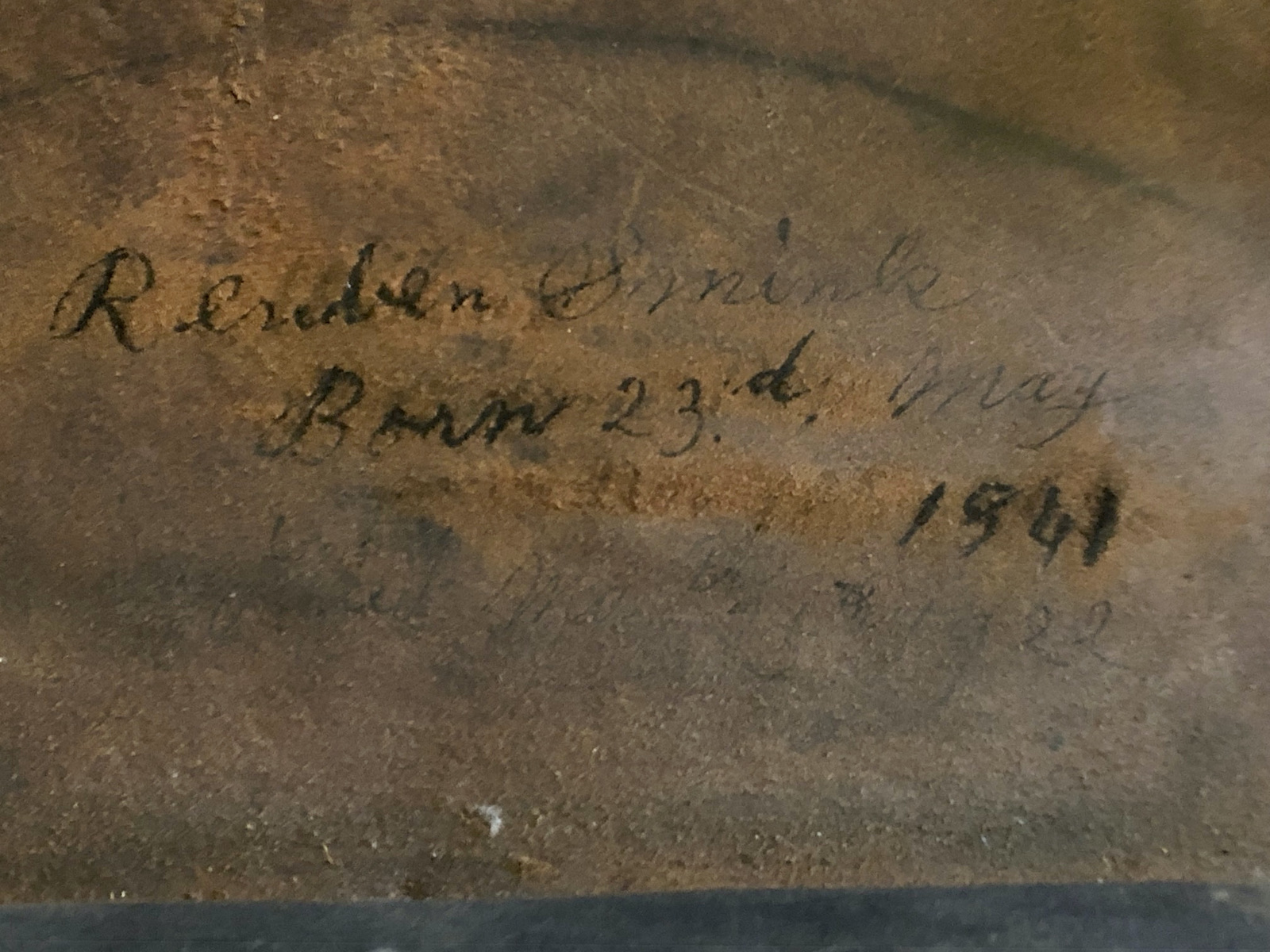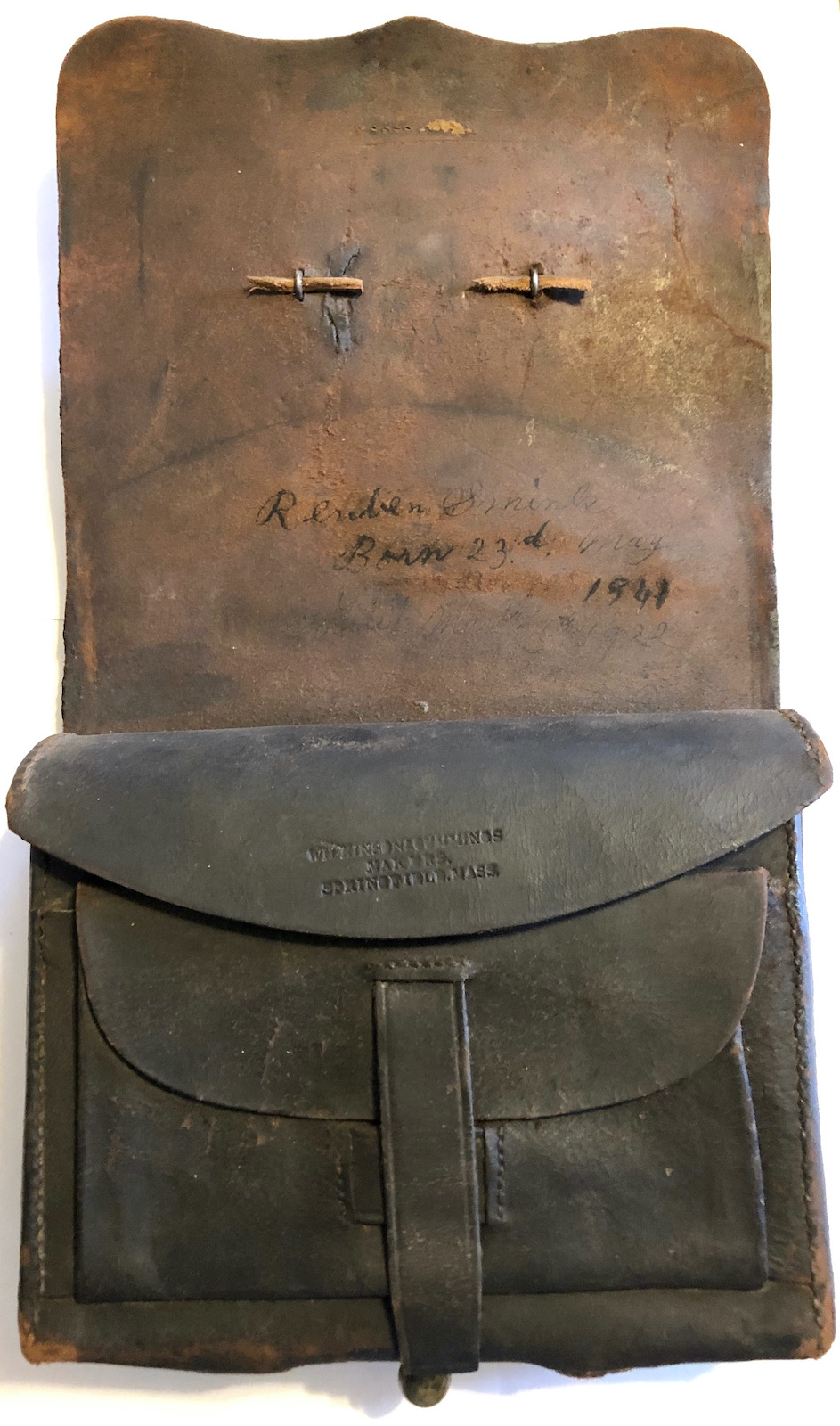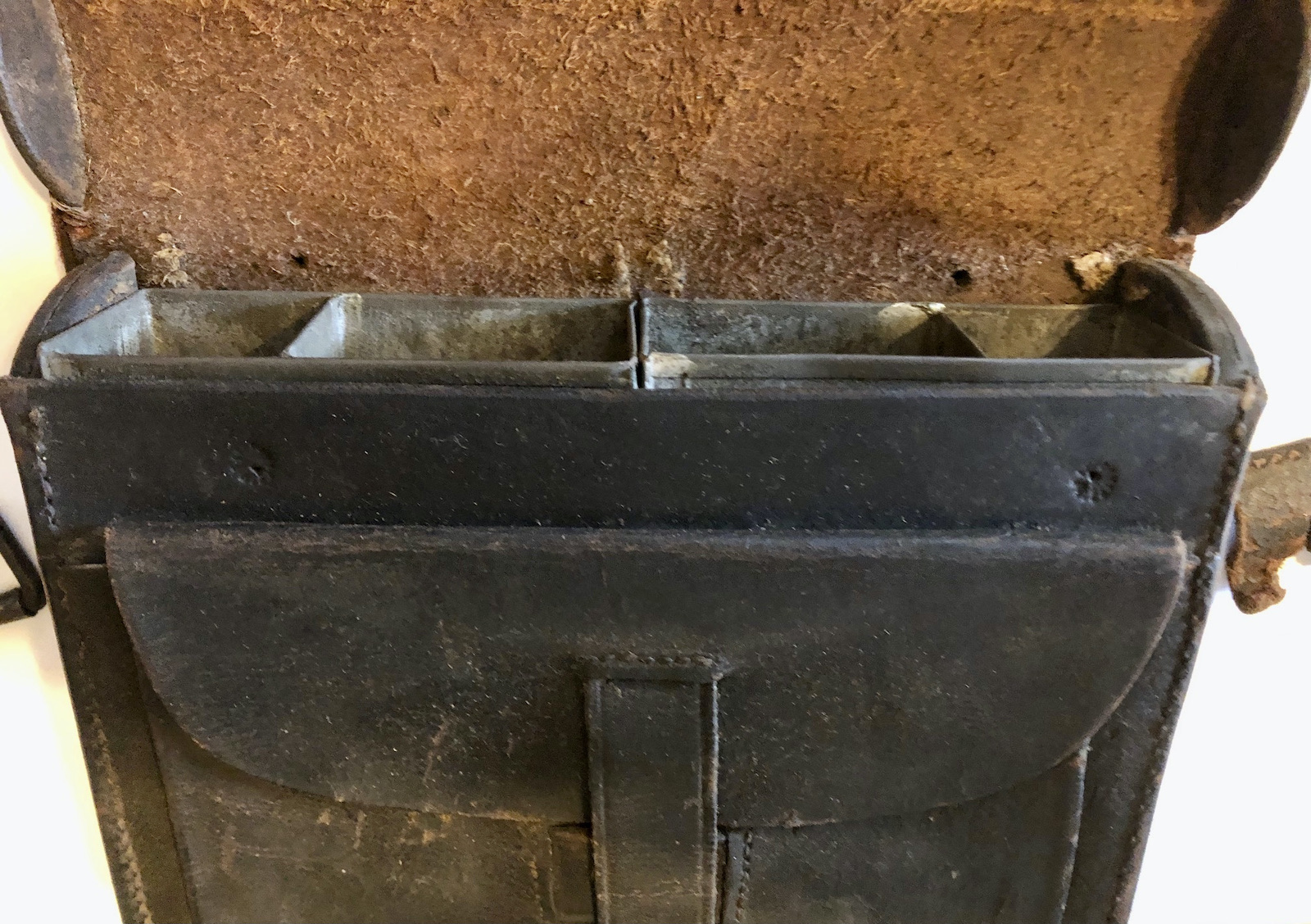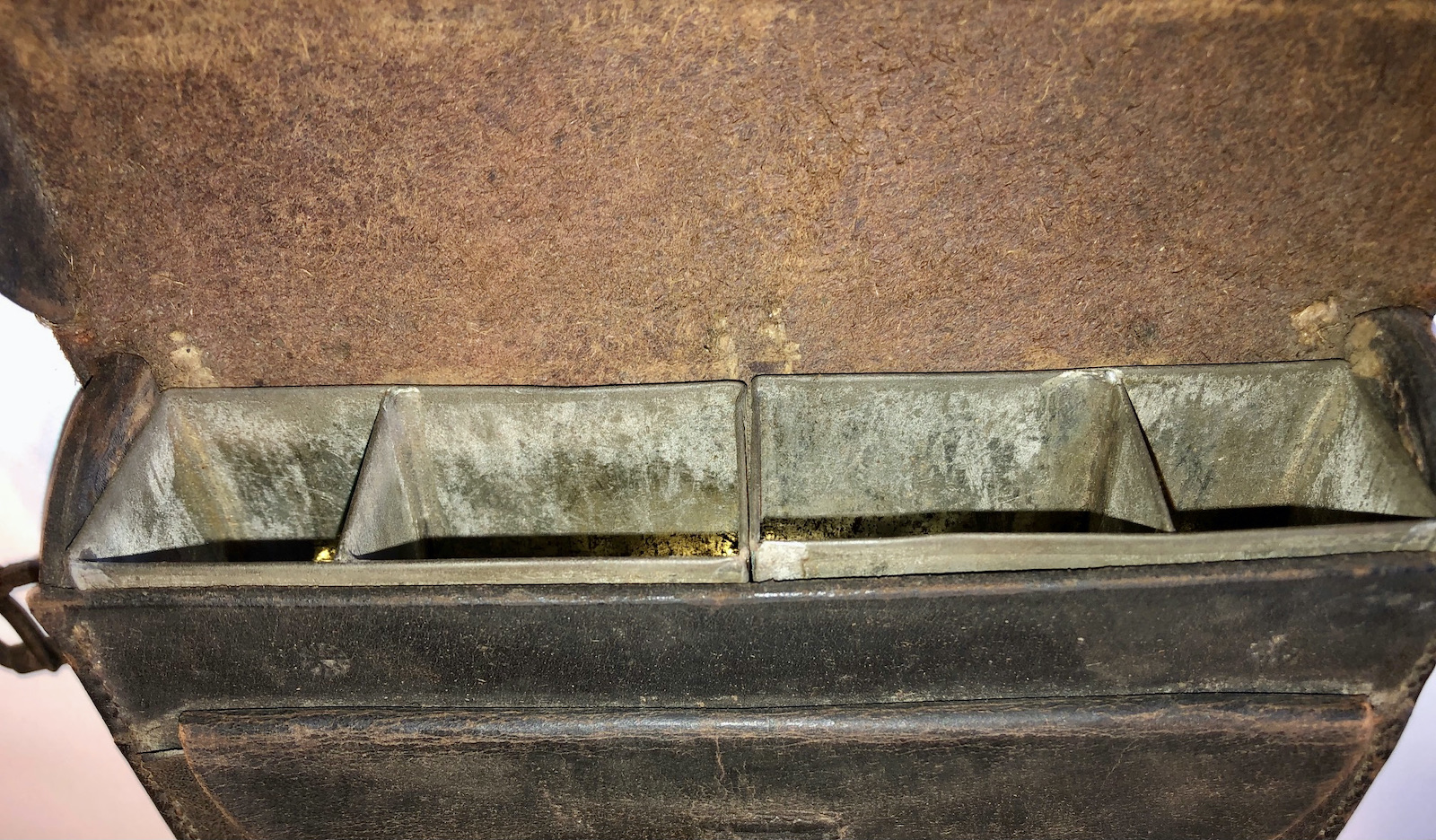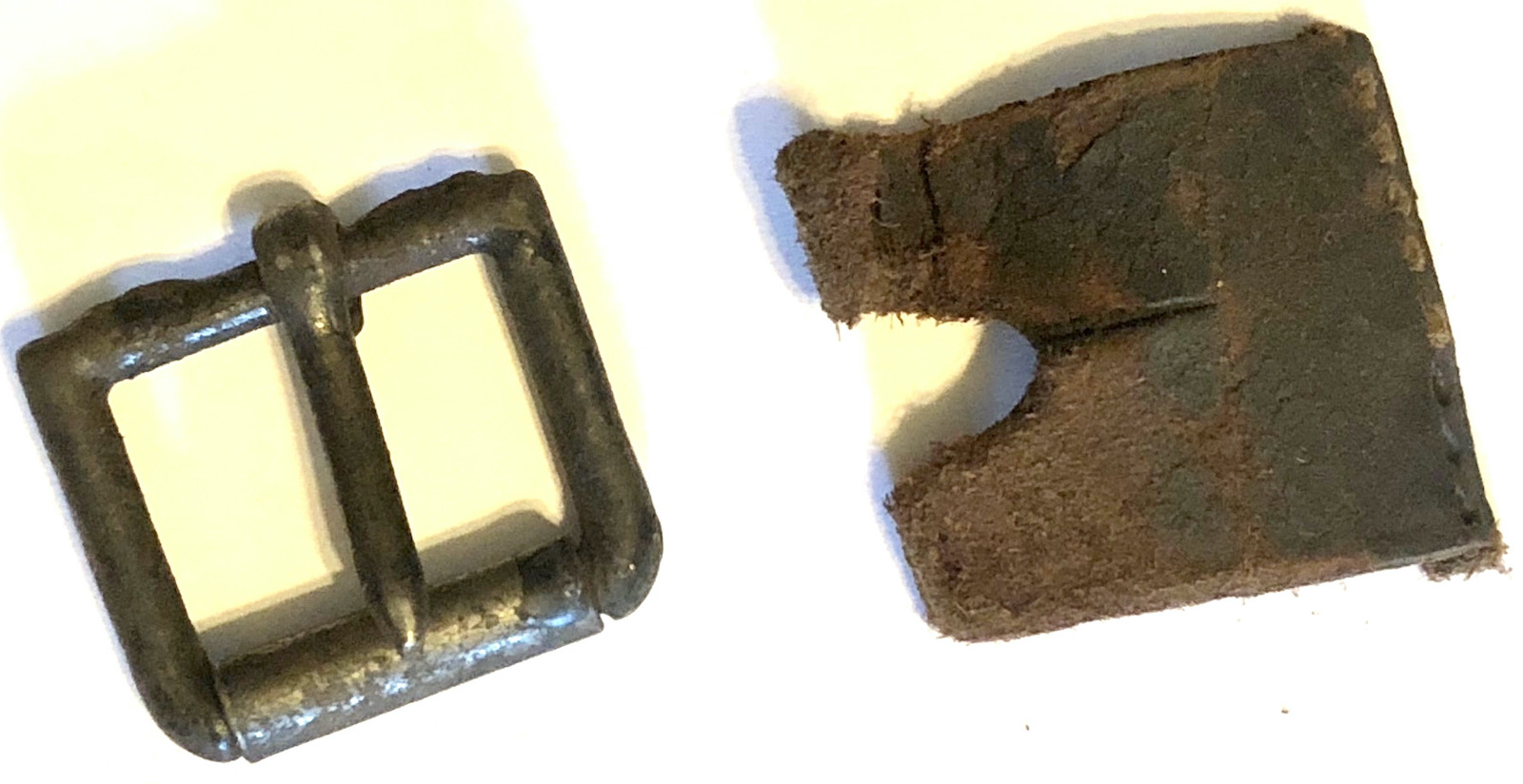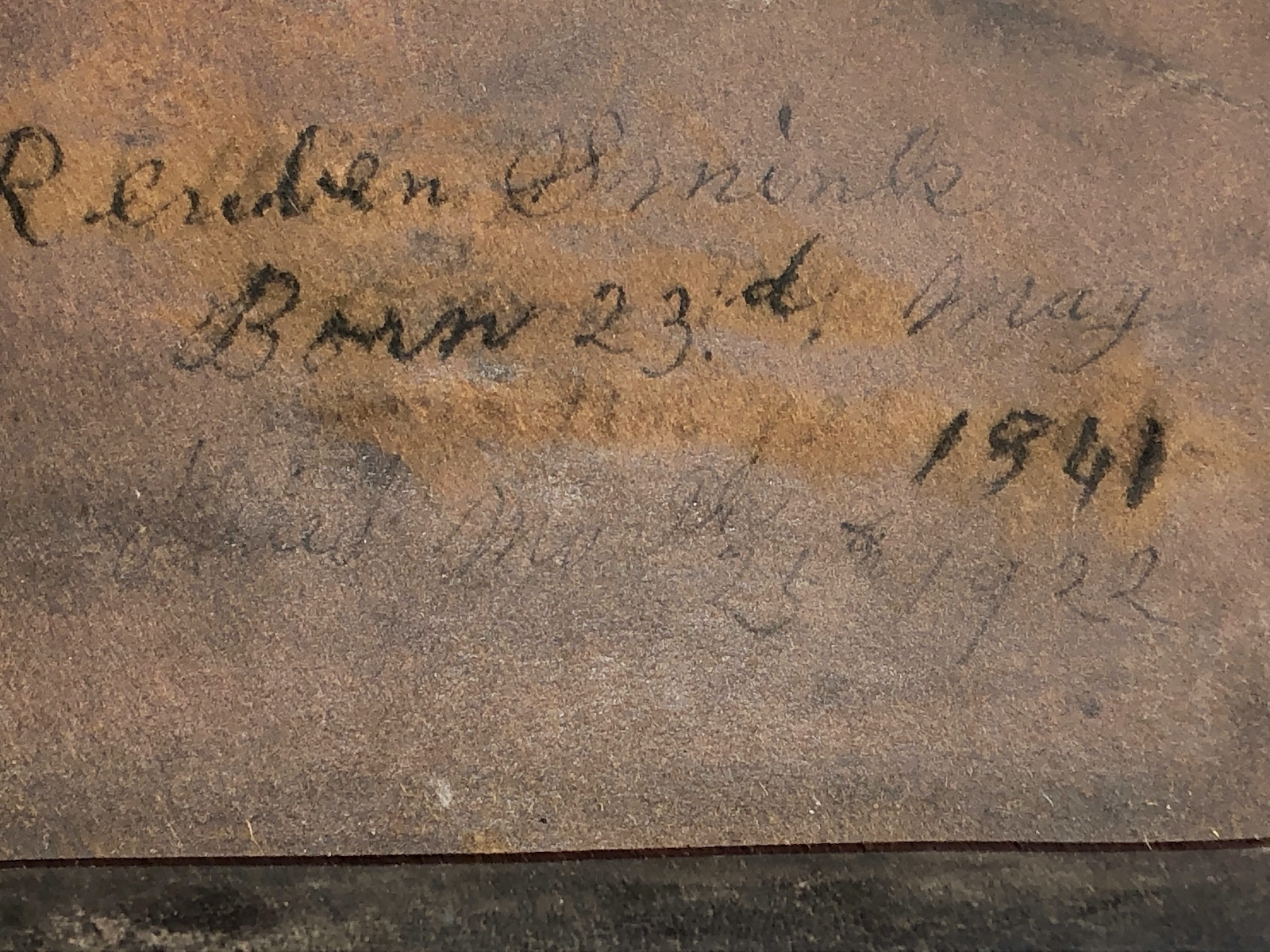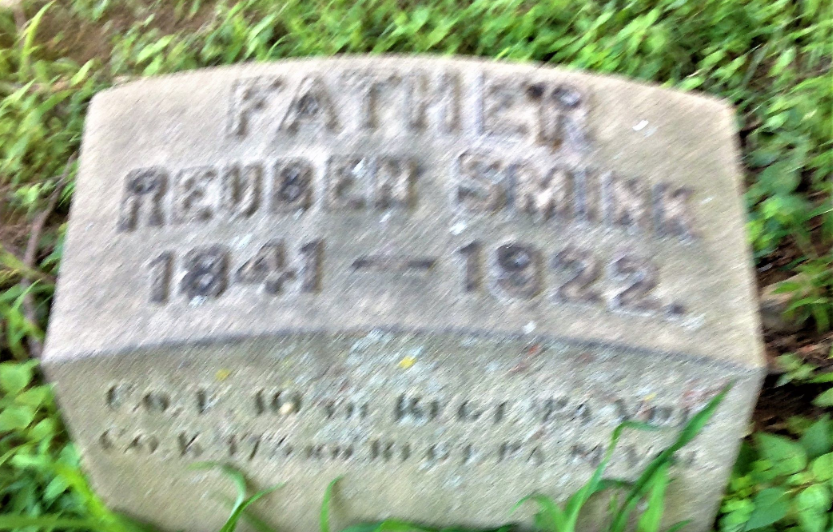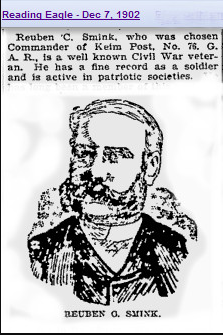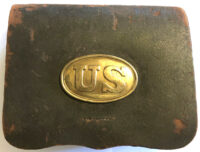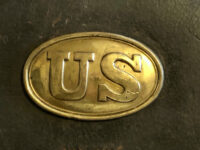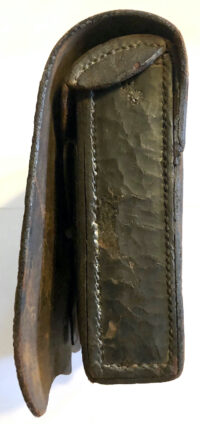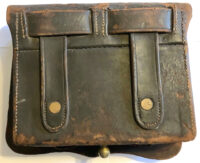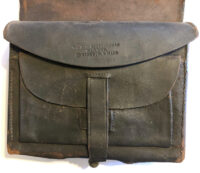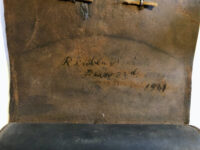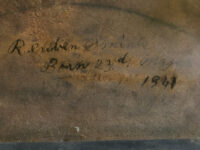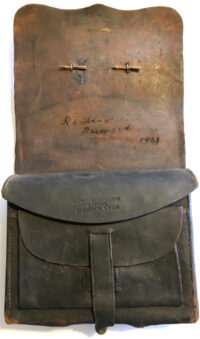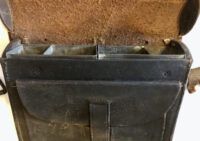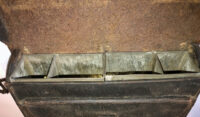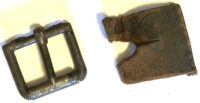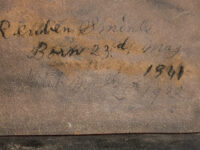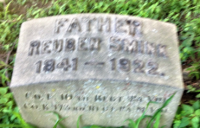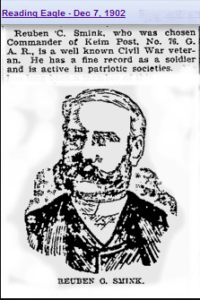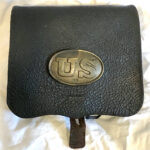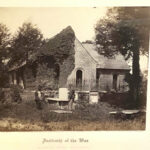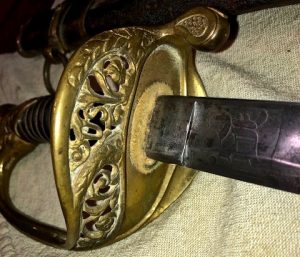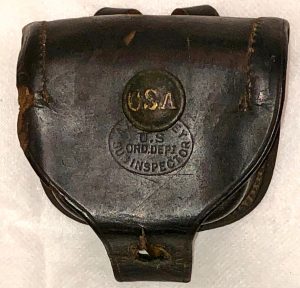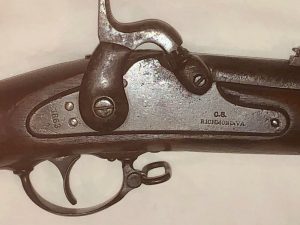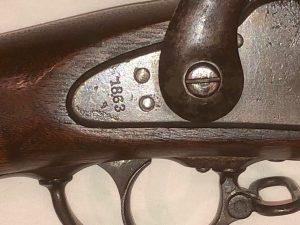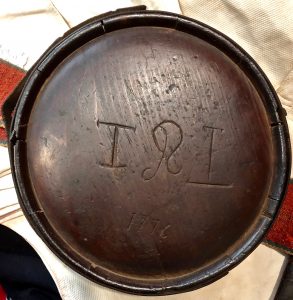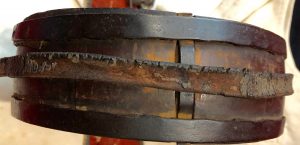Model of 1857 Pattern of 1861 Id’d Cartridge Box – 10th Pa. (3 Mos.) Infantry and 173rd Pa. Infantry (9 Mos.)
SOLD
Model of 1857 Pattern of 1861 Id’d Cartridge Box – 10th Pa. (3 Mos.) Infantry and 173rd Pa. Infantry (9 Mos.) – This is a nice example of an early war issue, cartridge box; inked and in pencil, on the interior of the cover, is the following:
“Reuben Smink
Born 23rd May
1841
Died March 25th 1922”
The cartridge box, which appears to be a box for the M1842, .69 cal. musket, issued to early war, state regiments, remains in very good condition, with the exception that both sling buckles have been cut off, perhaps in the period; there is one buckle remaining in the box; also, the closure tab has detached, with about half of that remaining, also inside the box. The leather and finish remain in very good condition, with only a very minor amount of loss, but no flaking. Both cartridge tins remain in place, as well as both side “ears” on the interior cover; the implement pouch and opening strap are in fine shape, and the box plate remains affixed to the front cover by original thong strips. Finally, the box has an early war style, large bulbous-shaped, brass, closure finial; the latch tab was sewn in place, not riveted. Stamped on the interior cover is the following:
“WILKINSON & CUMMINGS
MAKERS.
SPRINGFIELD. MASS”
Wilkinson and Cummings had U.S. Army contracts for infantry accoutrements from Aug. 1862 to April of 1863, as well as later contracts awarded to each maker separately. The names of the two manufacturers are found on cap boxes and cartridge boxes, the latter having US plates, affixed to the box covers. Their early contracts called for 10,000 sets of both cap boxes and cartridge boxes, for both .69 cal. and .58 cal. muskets.
Private Smink would serve during the war, in two Pennsylvania regiments – the 10th Pa. Infantry, a three-month regiment; later he enlisted in the 173rd Pa. Infantry, a nine-month regiment. We rarely find Id’d Union cartridge boxes, and this is an excellent example.
Reuben Smink
| Residence Lykenstown PA;
Enlisted on 4/26/1861 as a Private.
On 4/26/1861 he mustered into “F” Co. PA 10th Infantry He was Mustered Out on 7/31/1861 at Harrisburg, PA |
10th PA Infantry
( 3-mos )
| Organized: Camp Curtin, Harrisburg, PA on 4/26/61 Mustered Out: 7/31/61 at Harrisburg, PA |
| From | To | Brigade | Division | Corps | Army | Comment |
| Jun ’61 | Jul ’61 | 3 | 1 | Department of Pennsylvania | Mustered Out |
Pennsylvania
TENTH REGIMENT.
(3 months )
|
THE Tenth regiment was organized at Camp Curtin, on the 26th of April, 1861, by the choice of the following officers: Sullivan A. Meredith, of Philadelphia, Colonel; Oliver J. Dickey, of Lancaster, Lieutenant Colonel; Richard White, of Indiana, Major. Daniel H. Heitshue was appointed Adjutant. On the afternoon of the 1st of May, the regiment was ordered to move by rail to Chambersburg. Arriving late at night, it proceeded to Camp Slifer, where barracks, well provided with straw, had been prepared for its reception. With the exception of being too much crowded for new troops, the quarters were very comfortable. The following morning was cold and dreary, the earth being covered with snow. No provision had been made for the issue of rations, and men fresh from home, accustomed to a regular diet, became clamorous. Before evening, however, the farmers of the neighborhood, hearing of the wants of the men, came into camp with wagon loads of excellent bread, meat, pies, canes and pickles, making the hearts of the soldiers glad, not more by satisfying the cravings of hunger than by the spirit of sympathy and kindness which prompted the act. While in Camp Slifer the men received clothing, and were daily drilled. The camping ground, though in the main a healthy one, was exposed to the malerious influence of a swamp in the rear, which occasioned considerable sickness, and two men from company B, privates Charles H. Winters and Samuel Armbister, died. The regiment was assigned to the 3d Brigade of the 1st Division, and on the 8th of June received orders to march to Greencastle. Upon its arrival it encamped in a beautiful grove of oak and cedar, of some thirty acres in extent, about a mile north of the town, known as Camp Meredith. Remaining here, engaged in company and battalion drill, till the 25th of June, it was ordered to join in the general forward movement of General Patterson’s army. Passing through Middleburg, about midday, the regiment was halted, the citizens placing barrels and buckets of cool water upon the pavement, by which the men, now on their first march, foot-sore and dusty, were much refreshed. As the columns moved on, the smoke was discernable, hanging like a pall over Harper’s Ferry, from the ruins of the magnificent railroad bridge across the Potomac, fired by the order of the rebel General Johnston. After a fatiguing march of some twenty miles, the regiment went into camp near St. James College, about four miles from Williamsport. The ground occupied by the 3d Brigade was contiguous to the field where Major Ringgold organized and drilled his famous battery for the Mexican war, and where rest the remains of that gallant officer. The authorities of the college, being destitute of a United States flag, the members of the regiment furnished one, just previous to their departure, and unfurled it upon the buildings. On the 16th of June, the Brigade broke camp and moved to Williamsport, where, on the 18th, the regiment was sent out in two battalions, one under command of Lieutenant Colonel Dickey the other under Colonel Meredith and Major White, in anticipation that parties of rebels, following up the retreat of Colonel Thomas’ Brigade, which had advanced into Virginia two days before, and was now falling back, would attempt to cross the river at the many fords in this vicinity; but no enemy being discovered it returned to camp. On Monday, the 24th of June, Captain Doubleday having completed an earth work, placed in battery one smooth bore twenty-four pounder gun and one eight-inch howitzer, and opened on the toll house, a stone building situated about one mile from the river on the Martinsburg pike, and occupied by rebel scouts. The first shot struck the corner of the building, driving out a party of about twenty of the enemy, who were just then preparing to partake of a bountiful supper. Unwilling to leave the savory dishes, prepared with much care, the party halted at some distance from the house to consider the situation, but a well timed shell from the howitzer brought the conference to a sudden conclusion, scattering the party in all directions, amidst the cheers of thousands of Union soldiers who witnessed the scene from the Maryland shore. On entering the house on the following day the supper was found undisturbed. An order was issued on the 1st of July, for the whole army to advance into Virginia on the following morning. It was received by the soldiers with hearty cheers. They were impatient of delay, and desired to be led to victory. On that night there was little sleep in camp. Many were writing letters to their friends at home, while around the great camp fires, boiling, roasting, and frying were in full progress, in preparation for the march. During the night, a small train of wagons arrived from Hagerstown, with clothing for the Tenth regiment, which was greatly needed, the uniforms of many of the men being badly tattered. They were sometimes taunted by the well-dressed soldiers for their shabby appearance; but beneath their rags they carried hearts as stout and brave as any who kept step to the music of the Union ! Crossing the river on the 2d, the regiment advanced by the main pike towards Martinsburg. On the line of march, the traces of war were soon visible. Large fields of wheat, which had belonged to Union men, had been destroyed by the enemy’s cavalry. These loyal Virginians had fled from their homes for safety, and were now returning with the National columns to behold their homes pillaged, and their substance wasted. On the morning of the 3d of July, company B was sent forward to support the City Troop of cavalry. In the neighborhood of the Berkeley county school house a slight skirmish ensued, in which one of the enemy’s cavalry was killed and two wounded. In the afternoon the whole column marched into Martinsburg, amid demonstrations of joy and welcome from the citizens. The order to march on Winchester and give battle to the enemy having been countermanded, General Patterson, on the 9th of July, renewed his application to transfer his army to Leesburg, and to make that his base of operations. General Scott gave permission, by telegram of the 12th, to make the change of base desired, but ordered that demonstrations should be continued in front of Winchester until after the battle of Manassas, which, it was expected, would be fought on the 16th. At dress parade on the evening of Sunday, the 14th, the regiment was ordered to be prepared to move at daylight on the following morning with five days rations in haversacks. Taking the road to Bunker Hill, it soon became evident from the numerous camp grounds, that the enemy was in large force in front. The camps were located with great care on high and sunny ground, convenient to shady groves and large springs of excellent water. Remaining in the vicinity of Bunker Hill until the 17th of July, the regiment was ordered to march to Charlestown. Arriving at four o’clock, P. M., it encamped on an eminence to the west of the town. Union soldiers received little sympathy from the people of this strong hold of secession. Moving out during the night of the 20th about two miles on the road leading to Harper’s Ferry, where a considerable body of infantry and artillery was drawn up in line of battle, the Tenth was placed in position facing to the north, with the right wing resting on a thick wood, and the left on the river. Remaining encamped in position until the 23d, the disheartening news of our defeat at Bull Run was received. The campaign in Virginia was at an end. Marching on the 23d to Harper’s Ferry, the regiment was drawn up in close column to receive General Patterson and staff. Thanking the men for their soldierly conduct and strict attention to duty, the General said that he had advanced and offered the enemy battle in a fair field, which they had declined; that in the fight at Falling Waters they had been beaten by inferior numbers actually engaged; that, as the time of the three months’ men had expired, they were now to return to their homes. Three cheers were given for the General. On the 24th the regiment moved to a point opposite Antietam creek, where it forded the river and took up the line of march to Hagerstown. Thither it was taken by rail to Harrisburg, where, on the 31st of July, the men received their pay and were mustered out of service. |
Reuben Smink
| Residence Dauphin County PA;
Enlisted on 11/5/1862 as a Corporal.
On 11/5/1862 he mustered into “K” Co. PA 173rd Infantry He was Mustered Out on 8/18/1863 at Harrisburg, PA |
173rd PA Infantry
( 9-mos )
| Organized: Camp Curtin, Harrisburg, PA on 11/1/62 Mustered Out: 8/18/63 at Harrisburg, PAOfficers Killed or Mortally Wounded: 0 Officers Died of Disease, Accidents, etc.: 0 Enlisted Men Killed or Mortally Wounded: 0 Enlisted Men Died of Disease, Accidents, etc.: 19 (Source: Fox, Regimental Losses) |
| From | To | Brigade | Division | Corps | Army | Comment |
| Dec ’62 | Jul ’63 | Norfolk, VA | 7 | Department of Virginia | ||
| Jul ’63 | Sep ’63 | 1 | 2 | 11 | Army of Potomac | Mustered Out |
PENNSYLVANIA
ONE HUNDRED and SEVENTY-THIRD INFANTRY
(Nine Months)
|
One Hundred and Seventy-third Infantry. – Col., Daniel Nagle; Lieut.-Col., Zaccur P. Boyer; Maj., Grant Weidman. Five companies of the 173d came from Schuylkill county, three from Lebanon one from Perry and one from Dauphin. It was a militia regiment mustered into the U. S. service at Harrisburg, in Oct. and Nov., 1862 for nine months, and left Camp Curtin for Wash- ington on Nov. 30. It was then ordered to Norfolk, assigned to duty at Camp Veile near the city, where the winter was spent, and in May the regiment was ordered to provost duty in the city of Norfolk. On July 9, 1863, it started to join the main force in pursuit of Lee’s army after Gettysburg. At Frederick, Md., it reported to Gen. Meade and was attached to the 1st brigade, 2nd division, 11th corps. After wearisome marching it was posted on duty along the Orange & Alexandria railroad, until Aug. 13, when it was ordered to Harrisburg, where it was mus- tered out on the 18th. |
| NAME: | Reuben Smink |
| ENLISTMENT DATE: | 26 Apr 1861 |
| ENLISTMENT RANK: | Private |
| MUSTER DATE: | 26 Apr 1861 |
| MUSTER PLACE: | Pennsylvania |
| MUSTER COMPANY: | F |
| MUSTER REGIMENT: | 10th Infantry |
| MUSTER REGIMENT TYPE: | Infantry |
| MUSTER INFORMATION: | Enlisted |
| MUSTER OUT DATE: | 31 Jul 1861 |
| MUSTER OUT PLACE: | Harrisburg, Pennsylvania |
| MUSTER OUT INFORMATION: | Mustered Out |
| SIDE OF WAR: | Union |
| SURVIVED WAR?: | Yes |
| RESIDENCE PLACE: | Lykenstown, Pennsylvania
|
| NAME: | Reuben Smink |
| GENDER: | Male |
| AGE: | 21 |
| BIRTH YEAR: | 1841 |
| ENLISTMENT DATE: | 30 Oct 1862 |
| ENLISTMENT PLACE: | Camp Curtin, Pennsylvania, USA |
| MUSTER DATE: | 5 Nov 1862 |
| MUSTER PLACE: | Camp Curtin, Harrisburg, Pennsylvania, USA |
| RANK: | Corporal |
| UNIT TYPE: | Infantry |
| REGIMENT: | 173rd Pennsylvania Drafted Militia |
| COMPANY: | K |
Corp Reuben C Smink
| BIRTH | 23 May 1841
Pennsylvania, USA |
| DEATH | 25 Nov 1922 (aged 81)
Reading, Berks County, Pennsylvania, USA |
| BURIAL | Charles Evans Cemetery
Reading, Berks County, Pennsylvania, USA |
10th Regiment, Pennsylvania Infantry (3 months, 1861)
Brief History
This regiment was organized at Camp Curtin, Harrisburg, April 26, 1861. It mustered out July 31, 1861.
Companies in this Regiment with the Counties of Origin
Men often enlisted in a company recruited in the counties where they lived though not always. After many battles, companies might be combined because so many men were killed or wounded. However if you are unsure which company your ancestor was in, try the company recruited in his county first.
Field and Staff Officers – SeeRoster
Company A – Also known as “Maytown Infantry”. Men recruited at Lancaster, Lancaster County – SeeRoster
Company B – Also known as “Curtin Guards” . Men recruited at Bellefonte, Centre County – SeeRoster
Company C – Also known as ” Scott Rifles”. Men recruited at Tamaqua, Schuylkill County – SeeRoster
Company D – Also known as “Washington Light Infantry”. Men recruited at Pine Grove, Schuykill County – See Roster
Company E – Also known as “Lancaster City Infantry”. Men recruited at Lancaster, Lancaster County – See Roster
Company F – Also known as “Washington Rifles”. Men recruited at Lykenstown, Dauphin County – See Roster
Company G – Also known as “Washington Rifles”. Men recruited at Wilmore, Cambria County – See Roster
Company H – Also known as “Allegheny Guards”. Men recruited at Johnstown, Cambria County – See Roster
Company I – Also known as “Biddle Guards”. Men recruited at Huntingdon, Huntingdon County – SeeRoster
Company K – Also known as “Steuben Guards”. Men recruited in Lancaster County and Allegheny County – See Roster
Company F – Also known as “Washington Rifles”. Men recruited at Lykenstown, Dauphin County
| Smink | Reuben | Private | April 26, 1861 | Mustered out July 31, 1861 |
10th Regiment, Pennsylvania Infantry (3 months, 1861)
OVERVIEW:
Organized at Camp Curtin, Harrisburg, April 26, 1861. Moved to Chambersburg May 1, and duty there till June 8. At Newcastle till June 16. Attached to 3rd Brigade, 1st Division, Patterson’s Army. March to Williamsport June 16. Occupation of Martinsburg July 3. Advance on Bunker Hill July 15. Moved to Harper’s Ferry July 23. Mustered out July 31, 1861.
173rd Regiment, Pennsylvania Infantry (Drafted Militia)
OVERVIEW:
Organized at Harrisburg October and November, 1862. Left State for Washington, D. C., November 30; thence moved to Suffolk and Norfolk, Va. Attached to District of Norfolk, Va., 7th Corps, Dept. of Virginia, to July, 1863. 1st Brigade, 2nd Division, 11th Army Corps, Army of the Potomac, to August, 1863.
SERVICE:
Guard, outpost and provost duty at Norfolk, Va., till July, 1863. Ordered to Washington, D. C., July 9; thence moved to Frederick, Md. Pursuit of Lee July 12-24. Guard duty on Orange & Alexandria Railroad till August. Mustered out August 18, 1863.
Regiment lost during service 19 by disease.
173rd Regiment
Pennsylvania Volunteers
Company K
| Reuben Smink | Corporal | November 5, 1862 | Mustered out with Company, August 18, 1863 |
173rd Pennsylvania Infantry Regiment
The 173rd Pennsylvania Infantry Regiment lost 19 enlisted men to disease during the Civil War.
| 1862 | |
| October and November | Organized at Harrisburg under Colonel Daniel Nagle, Lt. Colonel Zaccur P. Boyer and Major Grant Weidman |
| November 30 | Left State for Washington, D.C. then moved to Suffolk and Norfolk, Va. |
| December | Guard, outpost and provost duty at Norfolk, Va. attached to District of Norfolk, Va., 7th Corps, Dept. of Virginia |
| 1863 | |
| July 9 | Ordered to Washington, D. C. then moved to Frederick, Md. and attached to 1st Brigade, 2nd Division, 11th Army Corps, Army of the Potomac |
| July 12-24 | Pursuit of Lee |
| July 25 | Guard duty on Orange & Alexandria Railroad |
| August 13 | Ordered to Harrisburg |
| August 18 | Mustered out |
